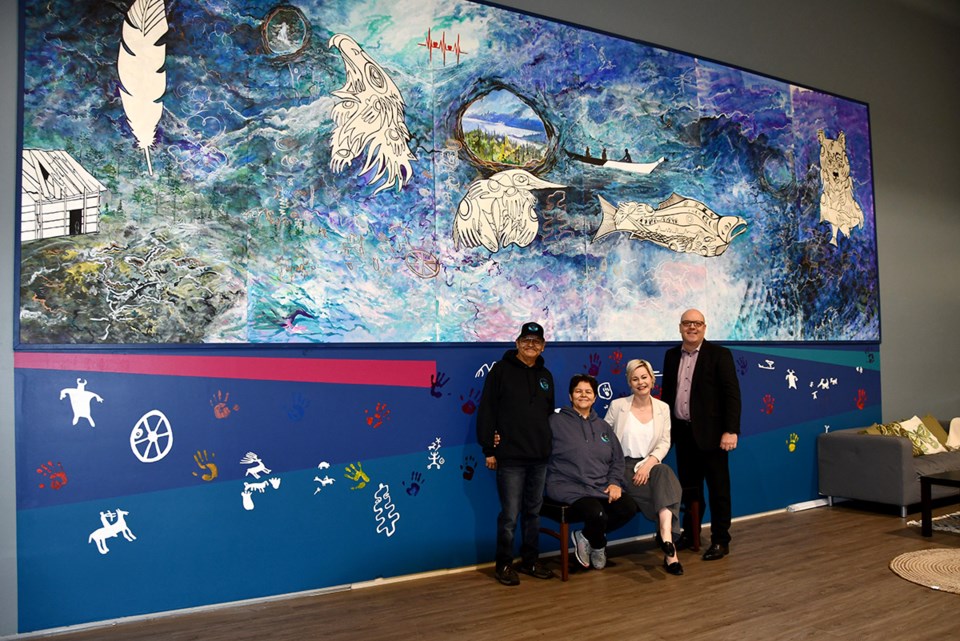Rosalie Dipcsu was excited to get the commission.
A member of the Sḵwx̱wú7mesh (Squamish) Nation and a longtime friend of kʷikʷəƛ̓əm (Kwikwetlem) Nation Chief Ed Hall, Dipcsu was just finishing a handpainted mural inside the new Red Fish Healing Centre for Mental Health and Addiction at səmiq̓ʷəʔelə/Riverview Lands in Coquitlam when PLEA Community Services came calling.
The social services agency had recently moved into a space in Port Coquitlam to assist at-risk youth in the Tri-Cities and staff were eager to find a meaningful way to acknowledge the unceded and ancestral lands of the kʷikʷəƛ̓əm of which they were now occupying.
Dipcsu thought about the kʷikʷəƛ̓əm’s spirit guardians she would incorporate in the mural for PLEA, as well as the nonprofit’s mission: to offer helping hands to those in need.
Then, overnight, she had a vision.
Jen Graham, PLEA’s communication and development manager, had emailed the corporate brand to Dipcsu.
Why not match the colours to the inside of an abalone shell? Dipcsu asked. After all, an abalone shell is a natural resource that’s been used for thousands of years by Indigenous people as a medicine bowl to hold sage, cedar and sweetgrass for smudging — a traditional method of cleansing and purifying the air.
Today (June 9), PLEA will host a private celebration to officially open the youth hub at 105-2071 Kingsway Ave., across from the Port Coquitlam Community Centre, and to unveil Dipcsu’s mural in the lounge that’s now being dubbed “The Warehouse” by youth and staff.
WAVES OF TIME
It wasn’t the easiest project for Dipcsu, though.
About half way through, she contracted COVID-19 and was bedridden for 45 days.
Anxious to complete the mural, her husband, artist John Dennis Williams and his daughter Maemie Baker, offered their hands while Dipcsu tried to rest.
In their North Vancouver home, the couple set up a machine to project Dipcsu’s drawings of KFN spirit guardians — an eagle, heron, salmon and bear — onto the canvas for the two to trace.
And when Dipcsu’s health returned, she used her acrylic paints to finish the 18’ by 24’ mural that weaves the stories of kʷikʷəƛ̓əm and PLEA.
With Chief Hall and KFN council’s guidance and blessing, Dipcsu created a water scene of the Nation and PLEA’s journey travelling over the waves of time.
She added peepholes, too, shaped like an abalone shell, offering glimpses to their past, present and future. In the top left corner, there’s a silhouette of the “Quekwatlen” Chief Thomas Williams from 1960, when he removed a curse on Coquitlam settlers (the same image is in Dipcsu’s mural, “Essence of “Spirit,” at Red Fish Healing Centre).
Still, she’s also included pictorial insights of Crystal Falls; the Coquitlam watershed (where kʷikʷəƛ̓əm’s winter home was wiped out by the dam construction); and a school of ooligans, a fish species that the neighbouring q̓ic̓əy̓ (Katzie) Nation is trying to revive.
In her mural titled “Helping Hands,” the KFN themes of struggle and renewal parallel to what youth at PLEA are going through, Dipcsu said.
“It could be rough waters ahead for them but, with the guardians looking out, at least they know where they are.”
As well, throughout “Helping Hands,” Dipcsu has ghost images of pictographs, the earliest form of writing.
“It shows that no matter where you are in the world, there are people trying to reach out and send the message that we’re all connected.”
HELPING HANDS
Pictographs are added to a painted extension below the mural.
At a recent gathering in the Warehouse attended by Chief Hall, several PLEA youth dipped their hands in paint to add their mark to the “Helping Hands” mural.
Her aim with the artwork? “It’s to make this place a welcoming, safe space for the kids to know that they will be understood here and that they will move on in life with new skills,” she said.
“This is way to celebrate them and their journey to freedom.”
PLEA executive director Tim Veresh told the Tri-City News the organization cherishes Dipcsu’s artwork, which can be taken down for exhibitions in the community.



